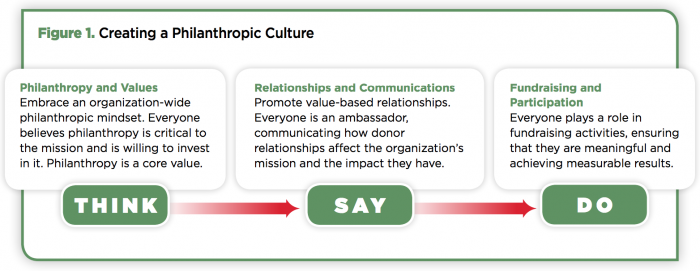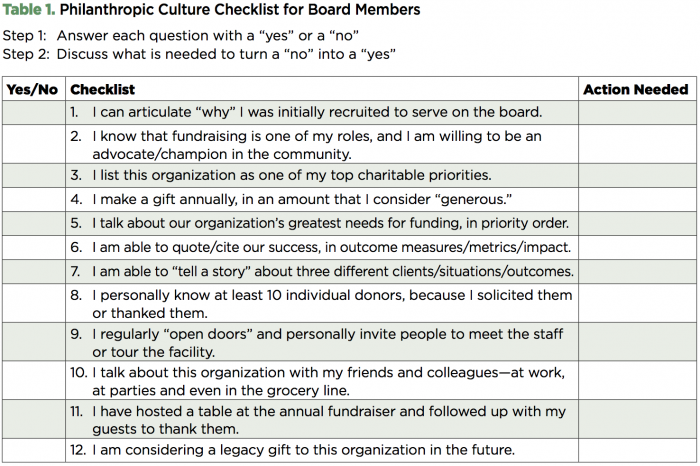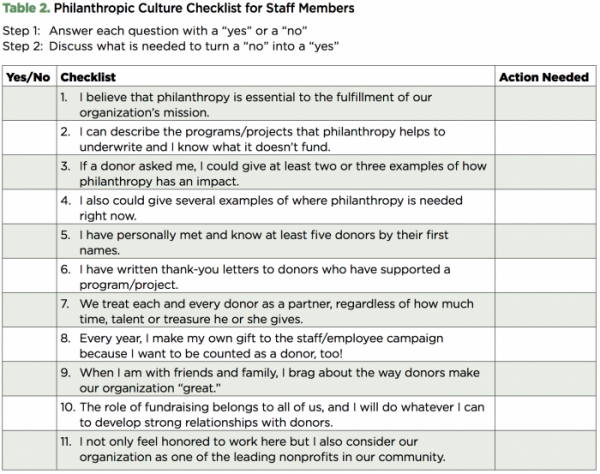
It is all the buzz, this thing called “philanthropic culture.” Everyone wants it, but what is it exactly? And how do you get one?
You have a philanthropic culture when your organization embraces philanthropy as a core value. With this mindset, people build relationships that are mutually beneficial and have impact on the mission. There is an organization-wide investment in fundraising.
A philanthropic culture is most certainly desirable but not so easy or quick to achieve. You must build such a culture. Culture-building requires thought leadership, values-based interactions and a strategic, intellectual and sometimes difficult process. It is more dynamic than didactic, and it takes time.
The measure? People think, say and do the things that make philanthropy an organizational priority. Their focus shifts from counting dollars to valuing relationships and results. Fundraising becomes everyone’s concern.
Are you willing to lead the effort? As a development professional, no one is better suited to inspire an organization to adopt a philanthropic mindset than you are. Your position as the catalyst for philanthropy makes it possible for you to influence virtually everyone else in the organization – to show them by example how to think, talk and act. It will not be easy being a change agent, and it will not happen overnight. To be sure, it will not happen on its own. You will have to own it, but in the end, give everyone else credit for creating it. That is how legacies are built and great fundraisers are made.
Simply put, you can influence how people in the organization think about philanthropy, what they say to build relationships and what they will do to reach fundraising goals.
Think
Teach the meaning of “philanthropy.” Think you can: “I can exhibit leadership and be a change agent. I will teach the concepts of philanthropy by showcasing how generous people want to partner with us to have an impact.”
Begin by constantly using the word “philanthropy.” If people do not know what you are talking about, explain what it means. Tell them how to spell it, define it and measure it. Give the word context by citing historic events, sharing donors’ stories, quoting community leaders and circulating human-interest articles. Help people understand that philanthropy is a values-based process that occurs when donors feel compelled to give, not pressured into it, because their interests specifically match an organization’s needs. Philanthropy is seldom transactional. It is transformative. Remind people that donors do not actually give away their money; they invest it. It is up to you and your organization to spend it wisely, as intended. Put the word “philanthropic” before the word “fundraising” to show that you are not begging or selling.
Are you willing to lead the effort? As a development professional, no one is better suited to inspire an organization to adopt a philanthropic mindset than you are.
As the leader of this cultural shift, you need to get people on board. Start with the CEO. Draft a philanthropic values statement that the leadership team can get behind. Be sure it is donor-focused. Then, engage board members. Invite them to make a list of their highest priorities for philanthropic gifts (no, not just to get cash to balance the budget). Help them see what can be funded at specific increments: $5,000, $10,000, $25,000 and even $1 million (or more). Dreams have a way of materializing.
Then, inspire staff. Show them the downside of not being a player on the community’s philanthropic map. Remind them that voluntary contributions are the litmus test of their mission’s value. Give them all the proper way of measuring philanthropy – measure what it does, not how much it is.
Your measure:
- To what extent does leadership value philanthropy? Do they see philanthropy as a way of thinking, talking and doing? Do they value human impact at least as much as they do financial impact? Is everyone willing to promote philanthropy and invest in it?
Say
Teach about relationships. Say you can: “I can show them how to articulate the value of our mission for the entire community. And I will show them that relationships are two-way and sustainable when they are reciprocal.”
How do you teach your colleagues about cultivating relationships to get support for their projects? Every discussion about relationships starts with values. Tell them, as Kay Sprinkel Grace expressed so well, “All philanthropy is based in values. Development of relationships is the process of uncovering shared values. Fundraising offers people opportunities to act on their values.”
Help them understand that donors want to be partners, not projects. Involving donors rather than just tapping them for cash means “more” comes when dreams are constructed together. Engage program directors in discussions about why donors give to their particular program – and why they do not.
Give examples of how they should talk to the greatest generation differently than to baby boomers and millennials. Board members and staff are fascinated by fundraising psychographics, in part because they affirm their own values in the discovery of knowledge. Explain that “giving” is an individual journey for everyone. You start by having to give and end up wanting to give. Money does not cause one to give. Generosity and gratitude do.
Introduce donors to everyone at your organization so they can see that “they” are not much different from “you.” Start with the newest intern, and work your way up to the leadership team.
Talk with staff, one-on-one. Ask each what he or she thinks money is needed for, and you will hear about the gaps, the excesses, the hopes and the troubles. Teach them how to articulate their cases for support with clarity, pointing out the mutual benefits to the donors and community. Help them write it, or write it for them! Teach them how to be “interested” in donors, in addition to being “interesting.” Make their case examples believable and urgent. Show how other similar nonprofits are using wish lists, videos, social media, human interest stories and, of course, measurable outcomes. Incite a little jealousy.
In a philanthropic culture, people do not feel entitled to philanthropy. They want to earn it. They earn it by making a case that is donor-focused.
Your measure:
- To what extent are donors valued as partners? Does everyone have contact with donors and the confidence to exchange ideas? Is the case for support critical, urgent and compelling?
Do
Teach them about fundraising. Do what you can: “I am going to reduce the fear and erase the embarrassment. I am going to show that fundraising is a ‘service’ that helps donors make meaningful decisions.”
Set the tone, and be the role model. Never beg or sell. Make fundraising a natural, enjoyable, respectful and successful activity. Show that fundraising is not haphazard but rather an organization-wide strategy. This does not mean that you want everyone to ask for money. Rather, ask them to assist – to be a conduit of the mission. In a philanthropic culture, virtually everyone (leadership, board, volunteers and staff) has a role to play in successful fundraising.
Identify those roles, make a list, ask for input, give people choices and allow their excuses. They can thank a donor, help write the case statement, make a presentation, refer a client/customer, invite a donor for a tour and even make their own gift. Invite board members, staff and volunteers to be hosts at events. Take them along on a donor visit. Ask them to send thank-you notes and birthday cards to “their” donors. Don’t set goals for them. Allow them to establish their own. They may surprise you and “own” a fundraising campaign. Hold focus groups, and invite them to sit in. Ask them to invite donors to share their stories at their staff or board meetings. Share articles about donor trends, fundraising ideas, etc.
When there is an organization-wide mindset that philanthropy is vital to your nonprofit’s existence, then fundraising practices and processes belong to everyone. They are natural, never forced.
When there is an organization-wide mindset that philanthropy is vital to your nonprofit’s existence, then fundraising practices and processes belong to everyone. They are natural, never forced.
Your measure:
- To what extent do people participate in fundraising? Are board members and staff willing (and prepared) to wear their nametags in public, give elevator testimonials at the drop of hat and volunteer to meet with donors anytime, anywhere?
The bottom line? In a philanthropic culture, mission comes first, then money follows. Donors are partners, not transactions. Board members are ambassadors, not bystanders. Employees are producers, not just performers. Development staff is respected, not shunned. And fundraising is honored, not avoided.
Karla A. Williams, M.A., ACFRE, is principal of The Williams Group in Charlotte, N.C. Her first article on the importance of creating a philanthropic culture appeared in Contributions magazine in 1995. A consultant, teacher, speaker and author, her Guide for Building a Philanthropic Culture in Your Organization will be published in early 2015.
Originally published in AFP Advancing Philanthropy Winter 2015 / www.afpnet.org



